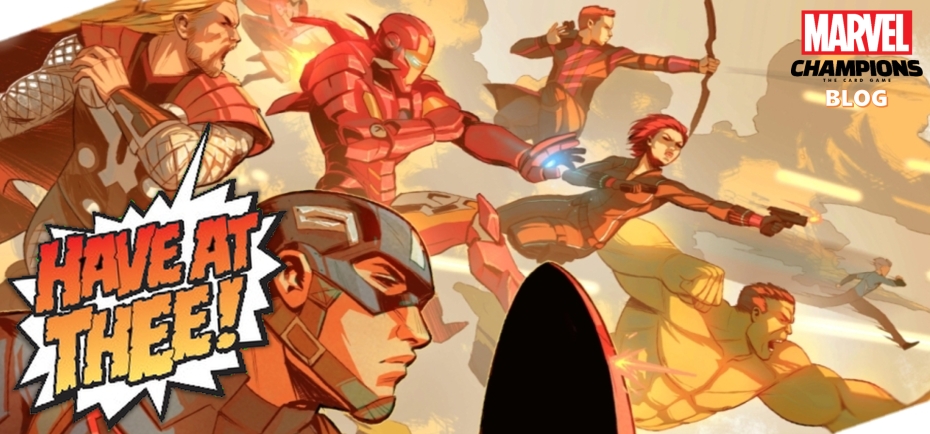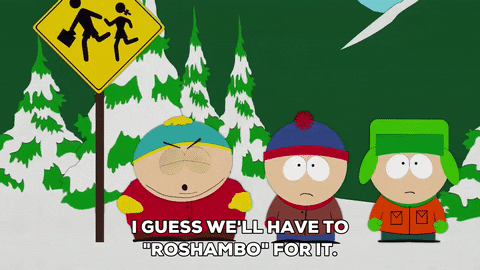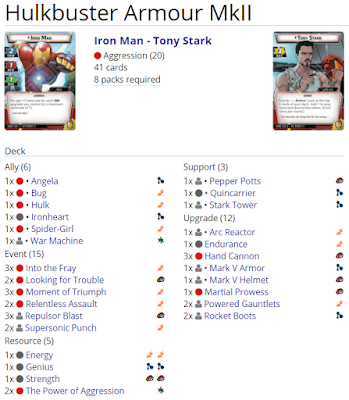A lot of my most recent blogs and deck ideas have been driven by my gradually changing a core approach to how I'm playing Marvel Champions. My successful run through the Rise of the Red Skull campaign with Ant-Man and Captain America had come by controlling the villain, taming their offense and threats then finally squeezing the life out of them once I was ready. It's the approach I took into my first run at the Galaxy's Most Wanted campaign with Ant-Man and Scarlet Witch but it's ultimately one that saw me fall short of controlling Ronan The Accuser.
A bit bruised from my encounter I ran back to the world of having fun with non-GMW scenarios. But the lesson stuck with me that my attempt to control Ronan had failed and, perhaps unconsciously at first, I shifted focus with my decks to move out of that comfort zone of being in control... to be faster and more aggressive.
I've shared the decks I've been enjoying exploring and playing along the way - Spider-Woman & Black Panther, Star-Lord, Iron Man - but I haven't shared the results of my exploits until now.
With the team of Star-Lord & Gamora I have faced the following...
- Kang - Expert: win in 4 turns
- Red Skull - Expert: win in 4 turns
- Brotherhood of Badoon - Standard: win in 3 turns
- Infiltrate The Museum - Standard: win in 2 turns
- Escape The Museum - Standard: win in 3 turns
- Nebula - Standard: win in 4 turns
- Ronan The Accuser - Standard: win in 4 turns
That's seven of the toughest Standard difficulty scenarios defeated in a combined total of 24 turns. And I'm not cherry-picking my results, by the way, those were back-to-back with each scenario defeated swiftly at the first attempt.
At first my progress was hesistant. I was new to Star-Lord and new to trying to rush villains instead of control them. I worked my way up through the scenarios slowly but as victory followed victory I got bolder. I never set out intending to face Ronan but having gone 2/3/4 turns as I worked my way through the GMW villains I wanted to see if I could beat Ronan in 5 turns and complete the pattern. I didn't do it 5 turns... I did it in 4 and was a whisker away from doing it in 3!
By the time Standard Ronan was in my rear view mirror I no longer had any doubts about the power of Star-Lord (I'm pretty sure he's better than Doctor Strange) and I was wondering if those sort of results were at all replicable with any other hero so I threw my Black Panther and Spider-Woman decks at Standard Ronan too. It was definitely harder with Wakanda Forever replacing Blaze of Glory as my big finisher, but I still successfully rushed Ronan down in 4 turns with these B-list heroes.
There was only one hurdle left to clear: Expert Ronan. This weekend I beat him with Star-Lord & Gamora in 4 turns at my first attempt. That's my first ever victory against Expert Ronan, with or without the campaign modifiers, and after struggling for so many games with great heroes like Ant-Man and Scarlet Witch the Star-Lord rush burned through Ronan like he was nothing. Again.
- Ronan The Accuser - Expert: win in 4 turns
"Rushing doesn't work, it's not reliable. Do you just fold the games where you don't get a perfect draw?"
"Maybe you can do it in solo but not multiplayer"
"Star-Lord is a really risky high variance character, dealing yourself all those encounter cards is going to mean you win some games and lose some games"
"Star-Lord won't work against somebody like Ronan, his cards are too good it's not worth the cost of giving him an encounter card"
"But it wasn't Expert Ronan. Rushing won't work against Expert Ronan - he has 11PP extra hit points over Standard."
WHY IT WORKS
At it's heart, Marvel Champions is an efficiency race between the heroes and the villain. The villain's efficiency is dictated by the rules of the game and the scenario - how many things he starts off with, how quickly he gains threat, how many cards he reveals from the encounter deck, how damaging those cards are or how difficult they are to deal with for the heroes. It's like jumping on a treadmill and setting it to a steeper or flatter incline while the heroes have the task of running fast enough that they don't fall off the back of the treadmill (and ideally fast enough that they've got a little left each turn to put towards actually winning).
This drive for efficiency is why some cards are good and other cards are bad. It's why Clear The Area is better than For Justice! for example - removing 2 threat for 1 card is more efficient than removing 4 threat for 3 cards. It's also why tougher villains throw out minions with larger hit points, it's so they can drain more of your resources in dealing with them and make you less efficient.
The most efficient response to any card the villain reveals is to ignore it completely because you're going to end the game before that card becomes relevant.
My game against Expert Ronan is an excellent example of this so I want to share it. Here is Ronan's board state at the end of the game...
When the game ended Ronan had 6 cards in play. I had completely ignored all of them (the Stunned Kree Commando was a side effect of Spider-Girl being played) because none of them stopped me from defeating Ronan before he actually made them count.
But looking at those cards on the table at the end of the game is far from the complete picture. During the course of the game I had dealt myself 26 encounter cards in four turns...
- 6 = 1PP x 2 heroes x 3 villain phases
- 3 = Kree Command Ship x 3 villain phases
- 3 = Universal Weapon, Cut The Power and Superior Tactics per the scenario
- 4 = 4x What Could Go Wrong?
- 3 = 3x Daring Escape
- 5 = 5x Surge keywords
- 1 = 1x shuffle the Universal Weapon away
- 1 = 1x Star-Lord emptying his player deck
- 26 TOTAL
Out of those 26 cards I had only had to slow down my rush to deal with 6 of them. I'd basically completely ignored over 75% of Ronan's cards!
You almost certainly won't have the firepower to rush the villain down by yourself and in putting damage to the villain ahead doing your part to solve threats like minions and side schemes you're just pushing more workload onto your teammates right at the point when they're trying to set up their economy cards for a long slog.
This is probably where the 'rushing only works in solo games' stereotype comes from, because when you're on a team of one you don't have anyone else to worry about bringing along with you. It's probably true that building decks to support an all-out rushing gets harder at higher player counts, but as the card pool deepens I think it gets easier and easier to avoid significant conflicts. If you wanted to then all four players could bring Aggression decks, for instance, and the only thing you'd have to worry about is cross-chatter in having the same unique allies in play at the same time.
Players avoiding the same aspects usually makes a lot of sense in multiplayer games but it's not essential, especially if you're building to rush the villain down. You don't have to be locked into the roles of "somebody needs to be Justice for schemes and somebody else needs to be Protection to keep us alive" because the answer to every question your team would face is "kill the villain before it matters" and so long as you've got a moderate amount of thwarting or healing in your hero kit it's probably enough for those clutch situations where it really matters.
Just make sure you've got likeminded players around you before you charge in!
Huh?
When I described why rushing was a successful strategy I explained that what you're really doing is removing the villain's agency from him - he can no longer affect the game. If the villain was another human player they'd be having a Negative Play Experience (NPE) because they weren't allowed to actually play the game. Thankfully the villains are just pieces of cardboard and don't have feelings, but ultimately that NPE may wind up bouncing off them and onto you - after all, you've just succeeded at winning a game of Marvel Champions by avoiding playing Marvel Champions.
If rushing has meant you're ignoring 75%+ of what the villain is doing and reducing them to just a cardboard punching bag then it's arguable that you've reduced the experience of playing the game to just being an exercise in scorekeeping. If you know your deck is reliably going to deal lots of damage and you know that the villain's cards aren't going to be able to stop you then all that's left is to watch it happen and keep track of the hit points. In the past I've been a bit scathing about all the solo decks that rely on the crutch of stunlocking the villain as essentially cheesing their way through the game by ignoring half of it... but a successful rush strategy seems to ignore more like three quarters.
Is what's left still enough of a game to be worth playing?
HOPPING ONTO MY STAR-LORD SOAPBOX
Is the game worth playing when you know you're going to win?
It's a question I'm asking myself now about Star-Lord in particular. That game I played against Expert Ronan wasn't just like having the satisfaction from finally climbing Everest it was like hiring a helicopter to fly me up to the top to take selfies as the summit: somehow it had all happened very quickly and very easily. Where am I supposed to go from here if I've trivially defeated the toughest villain in the game in 4 turns without even breaking a sweat? I could add the campaign cards in and go again, but the whole reason the deck works is that it doesn't card what cards the villain has so adding a few new cards is unlikely to change anything.
When I first introduced my Star-Lord deck last month I said "it's not the most dominant deck I've played...this is by far and away the most absurdly ridiculously bonkers, fun, death-defying and outrageous deck I've ever played". I'm a month wiser now and along the way I've become pretty sure Star-Lord rush actually is the most broken and powerful deck in the game for all the reason I've outlined above. Star-Lord rush literally transcends anything the villain can do and leaves them with blank cards. Doctor Strange has been the benchmark for broken heroes so far, and may fit more comfortably into any random assembly of heroes, but he still allows the villain to play the game in a way that Star-Lord doesn't. Winds of Watoomb is an incredibly good invocation but in What Could Go Wrong? I've got +3 cards stapled to Star-Lord's hero card for me to use it every turn without having to exhaust... and then if I get Star-Lord's helmet down I can effectively get to play two Winds of Watoomb every turn!
My experience of jumping aboard the Star-Lord rush train to see where it took me has been exhilarating - a wild ride that had a lot of white knuckle moments as I scraped through games that I had won just seconds before I lost them. Hindsight tells me now that the danger I felt was possibly an illusion and my victory was always assured.
I'm not done with playing aggressively but maybe it will soon be time to retire Star-Lord and play Marvel Champions again instead...

































